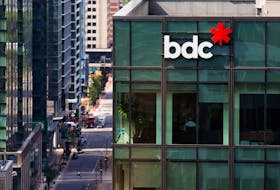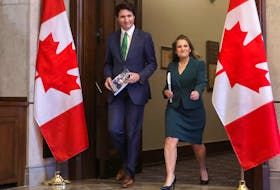The three members of Canada’s telecommunications oligopoly look pretty similar when viewed from the top line of a balance sheet.
Montreal-based BCE Inc. collected operating revenue of $23.9 billion in 2019, a two per cent gain from 2018; Toronto-based Rogers Communications Inc. took in about $15 billion, little changed from the previous year; and Vancouver-based Telus Corp. posted revenue of $14.7 billion, a two per cent increase over 12 months.
But they have different approaches when it comes to disclosing their use of the federal government’s pandemic relief.
Our investigation earlier this month of publicly traded companies that both claimed the Canada Emergency Wage Subsidy (CEWS) and continued to pay dividends turned up BCE and Telus, but not Rogers. It was surprising, especially since Montreal-based Cogeco Inc., a smaller telecommunications provider, also made our list.
It appeared Rogers had separated from the telco pack, but in fact there’s nothing special about Rogers, at least when it comes to taking advantage of public money for which it qualifies: The company also claimed its share of CEWS, while continuing to pay dividends, just like its fellow oligopolists, according to newly released data from the federal government.
The discrepancy could be innocent — a judgment call on what securities regulators would expect to see in terms of rescue funds received from the many programs governments set up to keep the COVID-19 crisis from turning into an economic depression.
But it highlights the inconsistency of the quality of public disclosures, and therefore necessarily raises questions about how seriously publicly traded companies take their obligation to be transparent. Some of the companies we analyzed in our investigation included CEWS payments as a line item, while others chose to barely mention them at all.
The Ontario Securities Commission, which oversees the bulk of Canada’s stock trading, insists that publicly traded companies are obliged to let the public know if they have benefited from COVID-19 assistance. “We have reminded companies of the importance of disclosing high-quality financial information to investors and published guidance on COVID-19 disclosure considerations,” said OSC director of corporate finance Sonny Randhawa, by email. “Examples of items requiring disclosure might include any subsidies and/or funding received from government programs.”
We missed Rogers because it chose a less obvious place to disclose that it had accepted the federal government’s help.
The investigation began with a single tip about a specific company that had raised its dividend while receiving the wage subsidy. Reporter Victor Ferreira and I scanned quarterly Management’s Discussion & Analysis documents to determine if the situation was unique. We came up with a list of 68 companies that took the emergency wage subsidy while continuing to pay dividends, which is legal, but nonetheless raises moral and governance questions, according to several academic experts.
Some companies will argue that dividends are sacred. (But) shareholders share income and loss. That’s why they are called shareholders
“Some companies will argue that dividends are sacred,” said Frank Li, a finance professor at Western University’s Ivey Business School. “On the other hand, shareholders share income and loss. That’s why they are called shareholders, they share. COVID is a good reason to cut the dividend. It’s a big macro-shock, so shareholders will understand if the dividend is cut. This is the kind of risk they must expect to bear when they buy the stock.”
Rogers avoided the Financial Post’s spotlight in our reporting earlier this month because the company’s MD&A disclosures made no mention of receiving a subsidy.
BCE and Telus were included on a second, shorter list of companies that declined to disclose the full value of the government payment they had received. BCE would only say its amount was “immaterial,” while a Telus spokeswoman said her company claimed “less than” two per cent of the roughly $1.5 billion that it paid in dividends through the early part of December.
Rogers, one of Canada’s biggest and most important companies, should have been on that list, too. Canada Revenue Agency this week set up a searchable database of all the corporations that have received CEWS. A search on “Rogers” turns up multiple listings for Rogers Communications Canada Inc. and Rogers Media Inc., the Rogers subsidiary that runs a group of cable channels, including Sportsnet and Citytv and dozens of radio stations.
We will continue to take corrective action where disclosures are potentially misleading
We would have determined that Rogers received the wage subsidy had we paid closer attention to its earnings calls. When asked whether the company had disclosed that it was receiving CEWS, a spokesman provided a transcript of the company’s second-quarter earnings call with analysts in July. “We did qualify for and receive some funding for our media business, that essentially ground to a halt,” said chief executive Joe Natale, who had to make a bet on whether professional hockey would resume. “The choices were to either furlough employees and have them go on individual subsidy, or to keep employees here, take advantage of that support mechanism,” Natale added. “Having people on standby and ready versus having to call them back from furlough was an advantage to us as a whole.”
Rogers probably didn’t do anything wrong in disclosing this way. The OSC and other regulators afford managers a fair amount of discretion when it comes to publishing financial information, which means companies can opt for translucent over transparent, according to lawyers who advise companies on their public filings.
For its part, the OSC said it will be watching. “This is an area that we’re monitoring closely in Ontario, and we will continue to provide guidance and take corrective action where disclosures are potentially misleading,” Randhawa said.
Email: [email protected] | Twitter: carmichaelkevin
Copyright Postmedia Network Inc., 2020








